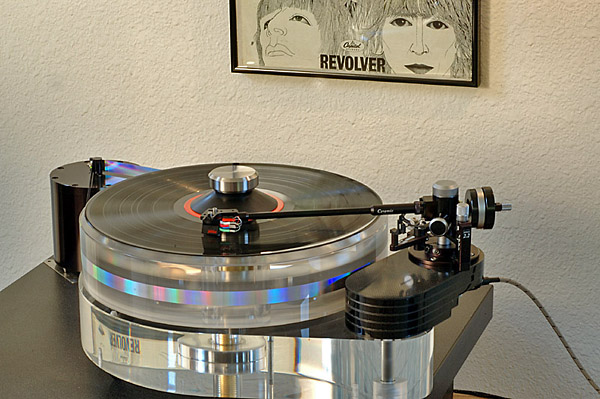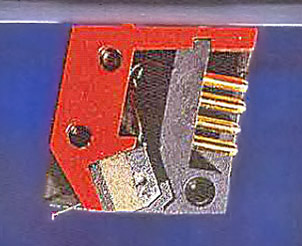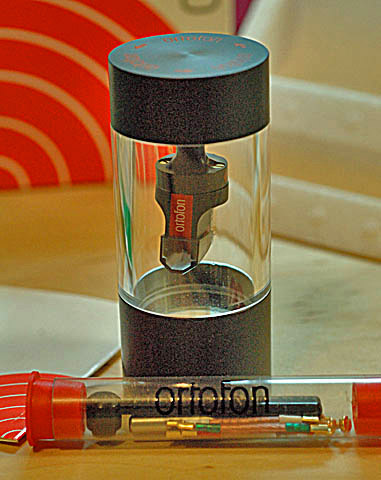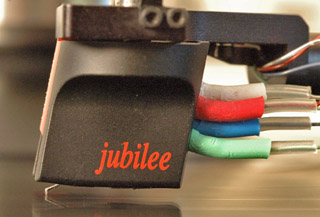-edible zone-

- Date: 11/2/06
- Author: Steve Clarke
- Model: MC Jubilee
- Category: Phono Cartridge, MC
- Retail Price: approx. ~ $1899.00
- Description: Moving Coil Phonograph Cartridge
- Manufacturer URL: http://www.ortofon.com/
- Manufacturer: Ortofon A/S
- Made in Denmark
- Distribution: Ortofon Inc. (in USA)
Specification:
- Output voltage .34mv
- Freq. Range 20 - 60,000 hz
- Freq. Response 20 - 20,000 hz
- Compliance 16 um/mN
- Stylus type Nude Shibatashibata_1.jpg (466850 bytes)
- Stylus tip radius r/R 6/50um
- Cantilever Solid boron rod
- Coil material 6-nines pure silver
- Magnet type Neodymium
- Tracking force range 2.0 - 2.5 grams
- Tracking angle 20 degrees
- Internal impedance, 5 Ohm
- Recommended load > 10 Ohms
- Cartridge body material Stainless Steel/aluminum
- Cartridge weight 10.5 gram

Above: section cut of the MC Jubilee
Mounting and aligning. The Cartridge comes with a kit of mounting and maintenance tools including a selection of yellow metal (gold plated?) slotted cheese-head screws, a nicely machined miniature screw driver, 4 cartridge tag leads and a -stiff- stylus brush. When held directly to a low powered magnet the supplied screws displayed no magnetic attraction. The cartridge itself comes mounted inside a protective acrylic cylinder for safe travel and storage.

Cartridge Mounting was straightforward. The cartridge body has M2.5
tapped holes installed at standard .5 inch spacing. I used stainless
steel internal hex cap screws to further simplify the mounting.
Unique to this Ortofon is an upper body surface providing three slightly
raised points in triangular layout. With a single point to the front
center, 2 rear, it is possible to adjust azimuth approximately two
degrees, on arms that otherwise would lack the adjustment, by tightening
one cartridge bolt while loosening the other, thusly tipping the angle
of the mounting. Likely owners of Rega RB series arms would find this
feature useful.
Cartridge posts are color coded. The supplied
owners manual provides a simple schematic for foolproof connection of
the headshell leads.
VTF was set at 2.2gram using a Shure SFG-2
balance scale
Overhang and Zenith Alignment was accomplished
using the supplied jigs and tools that came with the Graham 2.2 tonearm
being used for the review. Azimuth was set using the mirror method
described in the Ortofon user manual. VTA was set over time by ear using
the on-the-fly vta adjuster of the Graham arm.
The HFNRR test
record was used to measure lateral arm/cartridge resonance. At between 9
-11 hz. the cantilever shook the arm/cartridge. Good match-up. In the
test record bias tracks this arm and cartridge scored well completing
track 8 cleanly and only suffering a slight buzz on the much feared
torture track, band 9. Good tracking.
This review period ranges
from 5/16/06 to 11/3/06 (5-1/2 months). For the duration of the review
the cartridge was mounted to a Graham 2.2 uni-pivot tonearm. The
turntable in use is a Teres model 145 with DC battery power supply. Out
the bottom of the Graham 5-pin connector is a Silver wire Incognito
phono cable terminating into a pair of Sowter step-up transformers
(loading the cartridge to 100 ohms), then a Wright WPP100C tubed phono
preamp, then Belden 89259 coax interconnects terminated with Eichmann
Bullet Plug connectors. Those tie into the solid state Classe' CAP 151
integrated amplifier. Monster speaker cables terminate bare copper into
the NHT 2.9 four-way tower speakers.
 (click thumbnail for full image)
(click thumbnail for full image)
Listening room dimensions are 25ft long, 12 ft wide with a slant
ceiling 13-1/2 feet up at high end, 7-1/2 feet high at lower end. The
room appears to suffer no major acoustical problems. The recent photo
shows my listening environment.
Break in period:
The
cartridge seemed to do most of its breaking-in within the first 20 hours
when the high frequency became more extended and clean. Midrange bloomed
out a bit. Bass got faster and more extended.
____________________________________________horizontal rule
Impressions:
This is the most expensive cartridge I've used in this system to date.
With that in mind, I fully expect it to out perform anything used
previously, and in every way possible. Mostly, it does.
If I were
to sum up the MC Jubilee's sonic traits in a short paragraph, which I
can't, but if I were to try it would go something like this:
The
MC Jubilees' overall sound is rich, full, ambient, detailed, and with
loads of inner details cleanly defined. Leading edge transients are fast
with plenty of air. It delivers excitement and atmosphere. Notes sustain
long and with reverberant fading tails. There is a very strong rhythmic
drive. Music has a sense of timing. It gets to the melody. It is not
analytical. It is Refined. There is no harsh edginess. No unnatural
harshness. No perception of grain. It tracks very well. No miss-tracking
over high amplitude passages. It is neither forward nor laid-back.
Natural pure tones with no apparent colorations that I can tell.
Acoustic instruments are portrayed in glorious natural timbre. The
record inner grooves sound as good as the outer. Frequencies are
extended clear and natural in either direction without any apparent
roll-off. Trust me this one is good. OK, I'm done let's break for lunch.
Wait. Kidding. There's more.
Background: The MC Jubilee was
announced to the public in 1998, celebrating Ortofons' 80th anniversary.
The cartridge incorporated 'then new' design elements including a Metal
Injection Molding process (powdered metal) to produce its stainless
steel and iron parts. The new design build is a "pressed together"
assembly. No screws or adhesives. The armature and damping system
actually reside within the neodymium magnet. The cantilever is a very
thin, light boron rod, to reduce effective mass and speed up velocity.
Six-nines pure silver is used for the armature coils.
** Link here for the company brochure in pdf format. **
Classical Music listening:
Taking loudness measurements with a
Radio Shack spl meter, and for full orchestra listening I set the volume
level on the Classe' integrated amplifier high enough to achieve just
above 90 db during dynamic peaks.
Rachmaninoff Piano Concerto
No. 2 in C minor. Ian Davis. H. Lewis conductor, Royal Philharmonic
Orchestra. London SPC 21057 (Phase 4)
Full size concert grand
piano at stage front. Opening chord progression. Large chords combining
the upper cleff with the lower. Bass with the treble. The composers'
intention is to represent tolling bells. Slow of pace. Deliberate in
meter it begins softly but, with a steady crescendo, gains weight, force
and volume ultimately getting downright LOUD. Sound waves that initially
flow whisper-soft, soon crash-violent into torso and head with
percussive impacts. You feel it just as much as you hear it. That's how
the Moderato begins. For those who haven't experienced the full weight
and the 'volume power' that a concert grand piano can do, try this
recording. There is no distortion. At this volume the experience does
not hurt my ears. I like the piece.
Also on the classical music
listening list was another piano concerto; Rachmaninoff No.1 and the
Prokoiev No.3, Byron Janis, Moscow Philharmonic Orchestra. mercury
SR90300. This is a Mercury Living Presence 35mm magnetic film recording.
In this recording, the Jubilee was very good at providing details and
tones, rhythmic pace and tension. Somehow, though it did not have quite
the explosive dynamics as did the Shelter 501 mkII playing the same
piece through the same equipment.
The classical music list
included Lp recordings of ancient, Baroque, classical and the romantic
era. None of these exhibited indistinguishable massed strings or a
compressed wall of sound. Rather, the Jubilee was able to portray a
sense of the recording space, distinguish between all of the various
players, and get to the heart of the various melodic themes with much
detail.
Note: Not all classical music was listened to at 90 db
(peak) The chamber orchestra music was heard at between 60 and 80 db, as
was most of the jazz.
One of my favorite chamber orchestra pieces
is Vivaldi: The 4 Seasons. London FFSS CS6044. Karl Munchinger and The
Stuttgart Chamber Orchestra. Dead wax= ZAL 4035-6 2-E and 2-K. A warm
and marvelously vibrant recording of an excellent and moving performance
by the SCO. But what really works for me on this recording is the pace
and tempo of the thing. There is motion. At times a good bit of it. The
Jubilee conveys the timing and sense of pace of this recording better
than any cartridge I've heard so far!
Almost every recording I heard had a definable soundstage. Stage
dimensions were essentially similar.
Soundstage dimensions:
-- width: perhaps 1/2 foot to the outside of either speaker
-- depth:
a few feet in front and a few feet in back of the speaker baffles.
--
height is from knee level to a foot (or two) above the speaker
cabinetry.
The imaging is such that the players often become
disembodied from the speakers and operate within the volume of the sound
stage. While the imaging is not --overtly pin-point--, as in some
systems, there is a strong sense of 3 dimensional placement with each
player occupying a discernable area within the volume of the stage.
Example: Donovan, "Fat Angel" from the Sundazed mono re-master of
"Sunshine Superman". Articulate bongos in air popping out their adagio
tempo. They're up above, upstage and to the right. Guitar: The stroke of
the pick over damped strings. There is little body sound from this
guitar. (Like a solid body electric guitar with the amp turned off.) It
is strictly rhythm, downstage to the right below the bongos. The
electric bass is center stage, about even with the baffles, and floats
above the floor mid-cabinet. Its notes are also short on sustain
patterning a beat that plays to the bongo and guitar. The sitar rings
with a reverberant eastern ambience. It makes a counter melody to
Donovan's vocal, flying above, upstage and left. Finally Donovan's
voice, soft, breathing shallow and picking up the back beat. It occupies
a broader space at stage-front and center, above all but the sitar with
which it mingles. All very atmospheric and you are there in a smoky
Moroccan cafe.
_____________________________________horizontal rule
Impressions of "Someday My Prince Will come" Columbia CS8456 (2-eye,
2nd pressing)
"Teo"
Paul Chambers pinches the strings
tight against the finger board of his double bass, thus avoiding any
rattle between board and string. The resulting tone is a clean
combination of vibrating string and the resonating hollow hardwood body
of his cavernous instrument.
Cobb, striking out a clock-work
tempo between cymbal and wood block, lays down both the rules and
motivation for this piece. Winton Kelley's piano makes light sharp
strikes of chords in counterpoint to Cobb's meter.
'Trane doesn't
use vibrato. His wind power, coming up from the diaphragm, takes a
detour through the nasal passageway within his skull, thus coloring his
tones dark and slightly bitter. His -sheets of notes- trademark riffs
take on middle-eastern leanings. Miles colors his un-muted tones dark
and nasal then makes riffs in direct and similar answer to Coltrane. All
of this takes on a life within the listening room.
Comparisons Lp to CD. Santana "Abraxas"
-- Lp: KC30130 Orange
label Columbia from 1970 matrix Numbers: 1-E and 1-D original issue.
-- CD: CK30130 Columbia AD re-master from the 1980s.
This is an A
to B comparison playing first the cd then following with the Lp/Jubilee.
"Singing Winds, Crying Beasts"
Lp compared to cd:
- The Lp displays a soft background tape hiss that is completely absent from the cd.
- Wind chimes tinkle softly in space on the cd. Through the Lp wind chimes have more impact, edge and sparkle.
- Lp. The acoustic piano notes have more impact and texture.
- Lp. The Fender-Rhodes electric piano has more reverb and ambience.
- Lp. Electric Bass Guitar has better definition of leading edge string vibration as well as a weightier bass impact.
- Santana's guitar has more edge and sounds more alive thus giving a greater sense of soaring.
"Black magic Woman"
Lp compared to cd:
- Lp. The driving rhythm is more prominent and with the damped cow-bell strikes sounding sharper
- Lp. Santana's guitar soars gloriously but also you can sense that his playing is lending weight to the overall rhythmic drive. You don't get that from the cd.
- Lp. The vocal has more presence.
Imaging: cd to Lp: Soundstage and imaging is remarkably similar
between the two. Perhaps credit to the sonic visual trickery should go
to the recording engineer for creating this stereo soundscape. And
perhaps the Lp and cd share the same reference master tape. (just a
hunch)
Note: CD player is a Jolida JD100A
Comparisons with the Shelter 501 type 2 that it replaces in my
system:
The Shelters' strength is its liquid midrange, Intimate
vocals and finely textured instrumentals. But also, not to be
overlooked, are its fast leading edge transients that give air, detail
and excitement to the music.
The Jubilee doesn't quite manage the
midrange intimacy of the Shelter. Comparatively, its midrange is not so
much liquid as just natural and coherent with the rest of its frequency
range. Female vocals don't appear with quite so much "in the room"
intimacy, yet they are the indeed in the room. Ditto acoustic
instruments like piano and harpsichord, guitar, bass violin, etc.
The Jubilee reproduces bass that is tight, textured, full bodied and
weighty. The Shelter gets that too except with less weight and slam.
The Jubilee is better at fleshing out the individual within the mass
of instruments re: full orchestra music. The Jubilee gets a stronger
sense of tempo and timing across than does the Shelter.
The
Shelters' weakness is its occasional bout of miss-tracking over high
amplitude tracks and the occasional slight edginess and harshness. The
Shelter seemed to favor certain kinds of music like small combo jazz,
baroque period chamber music, acoustical music and the human voice. The
MC Jubilee does not seem to have any such tendencies. Rather, it seems
to favor no particular genre of music while excelling at all of them.
Needle drops: Soft of impact, The Jubilee's nude-mounted Shibata
stylus gracefully slips into the lead-in groove. Quiet of surface noise.
In sharp contrast, the Shelter 501-II snaps abruptly into the lead-in
groove.
Indeed the MC Jubilee displays no faults of any kind that
I can find while never failing to get to the heart of the music..
To sum it up, the biggest problem I had in putting together this
review was to force myself into a critical listening frame of mind. It
is just too easy to relax and enjoy the music coming out of this item.
The MC Jubilee has impeccable timing that never fails to find the tempo
within the melody nor the ambience within the hall.
End review.
Associated Equipment:
- Turntable: Teres model 145
- Tonearm: Graham model 2.2
- Tonearm cable: Incognito silver
- Turntable shelf: Neuance Beta
- Turntable mounting: Short, wide solid oak table weighed down with 100 lbs of granite
- Phono Stage: Wright WPP100C with Sowter step-up transformers
- Integrated Amplifier: Classe' CAP151
- Speakers: NHT 2.9
- Interconnects: Belden 89259 coax with Eichmann Bullet RCA plugs
- Speaker Cable; Monster 2R-CL terminated bare copper
